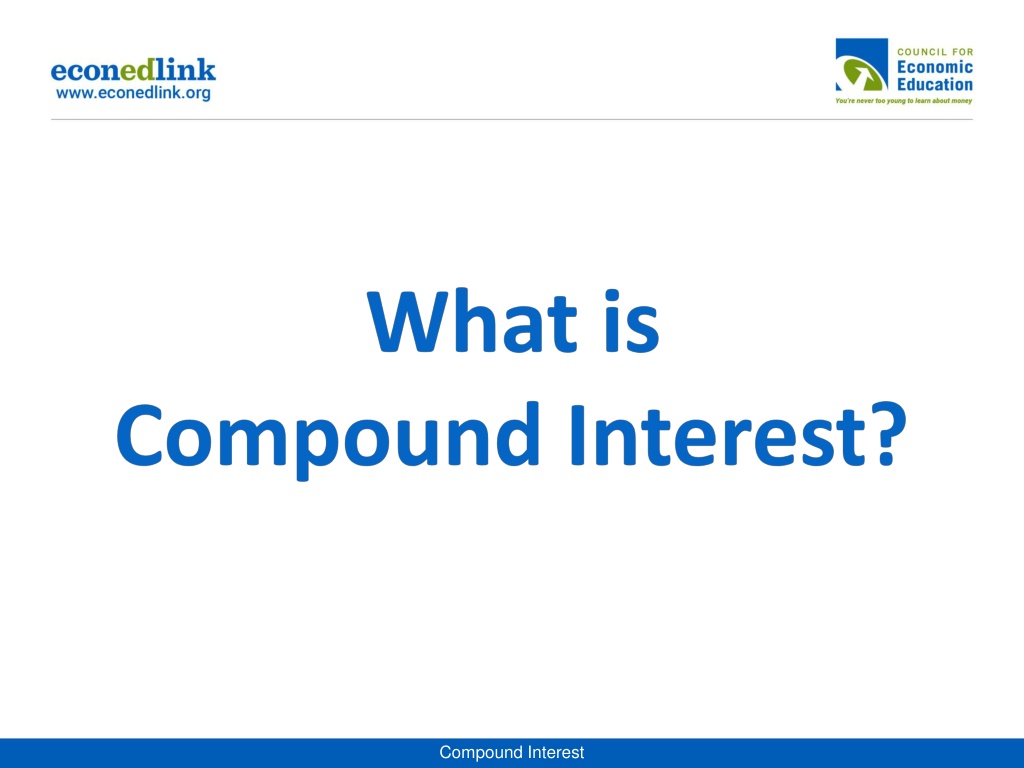Understanding Compound Interest and Simple Interest Formulas
Interest rates play a crucial role in financial transactions. Compound interest is earned on both the principal and accumulated interest, while simple interest is earned solely on the principal amount. Different compounding frequencies affect the overall interest earned. Learn how to calculate simple interest and compound interest, and how the formulas differ in this informative content.
Download Presentation

Please find below an Image/Link to download the presentation.
The content on the website is provided AS IS for your information and personal use only. It may not be sold, licensed, or shared on other websites without obtaining consent from the author. Download presentation by click this link. If you encounter any issues during the download, it is possible that the publisher has removed the file from their server.
E N D
Presentation Transcript
No-Frills Money Skills Video Series, Episode 1 https://www.youtube.com/watch?v=aqu8pALMtOs Compound Interest
Interest rate: the price paid for using someone elses money, expressed as a percentage of the amount borrowed. Compound interest: interest earned on both the principal and any interest that has been earned previously. Earned on accounts at banks, credit unions, etc. Earned on certain investments such as annuities Paid on most consumer loans, car loans, mortgages, and other unpaid credit balances Simple interest: interest earned only on the principal. May be used on some consumer loans and some types of savings Easier to calculate but not as commonly used Compound Interest
Interest can be compounded over different lengths of time including: Annually computed and added at the end of each year Semi-annually (twice a year) computed and added every six months Quarterly (four times a year) computed and added at the end of each quarter (three months) Monthly computed and added at the end of each month Compound Interest
Dianna deposits $725 into a savings account that pays 2.3% simple annual interest. How much interest will Dianna earn after 18 months? Compound Interest
To calculate simple interest we use the formula I = Pxr xt I is the interest earned P is the principal or the original amount of money with which you start r is the annual interest rate as a decimal t is the time in years. Compound Interest
The annual interest rate is written as a decimal. (2.3 = .0023) In the simple interest formula, time is measured in years. (18 months = 1.5 years) I = Pxr xt Interest earned = $725 x .0023 x 1.5 Compound Interest
Determine the amount of interest earned. Use the formula for simple interest. Problem 1 Principal: $550 Annual rate: 7% Time: 4 years Problem 2 Principal: $870 Annual rate: 3.7% Time: 30 months Compound Interest
Use this formula to calculate compound interest: A=P(1+r)t A is the amount of money in the account at the end of a time period P is the principal r is the annual interest rate t is the time in years Compound Interest
Simon deposits $400 in an account that pays 3% interest compounded annually. What is the balance of Simon s account at the end of 2 years? Compound Interest
Step 1. Find the balance at the end of the first year using the simple interest formula I = Pxr xt $400 x .003 x 1 = $12 $400 + $12 = $412 Step 2. Find the interest at the end of the second year using the simple interest formula and the principal of $412. $412 x .003 x 1 = $12.36 $412 + $12.36 = $424.36 Compound Interest
Jackie deposits $325 in an account that pays 4.1% interest compounded annually. How much money will Jackie have in her account after 3 years? Compound Interest
Use the following compound interest calculator to determine the amount earned by age 65, starting at two different ages. Start saving $50 a month at age 18 at 4% interest Start saving $50 a month at age 30 at 4% interest https://econedlink.org/resources/compound-interest-calculator/ Compound Interest


























